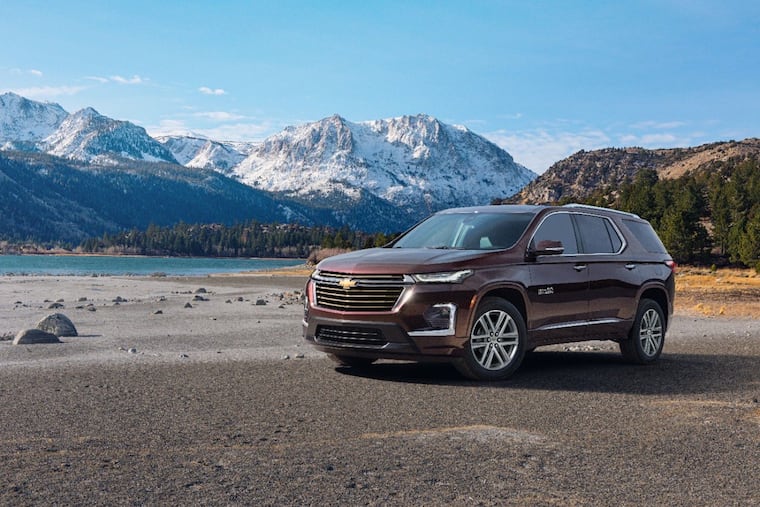2022 Chevrolet Traverse: Space for the family, but forget the driver
As we wrap up our comparison of the Chevrolet Traverse and the Kia Sorento PHEV, the choice comes down to people and cargo holding, or letting the pilot enjoy the ride.

2022 Kia Sorento PHEV SX-Prestige AWD vs. 2022 Chevrolet Traverse High Country AWD: Once among the least-liked SUVs tested; how do they fare now?
This week: Chevrolet Traverse
Price: $54,595 as tested. And everything noted is standard on the High Country trim level, a very un-GM-like move.
Conventional wisdom: Car and Driver likes the “spacious cabin, peppy acceleration, fuel-efficient powertrain,” but not the “big blind spots toward the rear, plasticky interior parts, most appealing options cost extra.”
» READ MORE: 2022 Kia Sorento Plug-In vs. Chevrolet Traverse: Fun and economy or space and comfort?
Marketer’s pitch: “A mid-size SUV with full-size flex.”
Reality: Forget fun and bring the family.
What’s new: The Chevrolet Traverse gets a freshened look for 2022, along with new driver assist and connectivity features.
Up to speed: The 3.6-liter V-6 provides 310 horsepower, and the testers at Car and Driver report that the Traverse gets to 60 mph in 6.5 seconds.
But the Traverse can lack responsiveness in many everyday driving situations. I thought it could feel like an aging bull trying to get up to speed, especially when starting from a stop at the bottom of a hill, or when trying to maintain a speed while climbing a short hop on country roads. (Lord knows many drivers need help maintaining their speed as road angles vary.)
I point this out because it’s a full second quicker than last week’s Sorento, so how can the Sorento feel spry and peppy? It’s just a matter of where the power shows up. The electric motor adds torque for small hills and speed changes.
But after reading C&D’s numbers, I put the Traverse to the test and found that it does roar when you push it. Still, I’d prefer something with more oomph for less effort.
Shifty: The culprit could be the 9-speed automatic transmission, which in other models has shown difficulty finding the right gear on occasion. In fact, beyond lackluster performance at start-up, the Traverse did seem to have more than a few bouts of shuddering while climbing small hills or accelerating out of curves, creating problems right at the point a vehicle could start to feel fun, and in the Sorento’s sweet spot.
On the road: Speaking of curves, the Traverse seems averse to them, not surprisingly. It’s a large family unit, but even for its category, the wheels were ready to leave the pavement in short order. I took my usual winding road test at 10 mph below my usual test speed and thought “Welp, this is about as fast as I’d want to go. Or maybe even faster than I’d want to go.” A Sport mode might liven things up.
It’s a fine highway companion, though, gliding over bumps and along straightaways, and passing without worry.
Driver’s Seat: It’s a not-uncomfortable ride in the Traverse, with a cushy and supportive seat that seems above GM’s usual standards. We rode the 40-mile trip into Philadelphia and spent a lot of time in stop-and-go traffic, and the Traverse left me feeling just fine when the riding was done.
General Motors is sticking with its narrow typeface and gauge designs that hark back to the Aughts, so fans will be pleased; the rest of us, not so much.
Friends and stuff: The Traverse has always provided generous accommodations for the family and it stays true to that heritage. The second-row captain’s chairs in the test model slide back and forth — and setting up a comfortable position for 5-foot, 10-inch Mr. Driver’s Seat in the middle left a comfortable perch for a second Mr. Driver’s Seat in the back. Headroom, legroom, and foot room are all comfortable in all rows.
Cargo space is a generous 98.2 cubic feet behind the front seats, 57.8 behind the second row, and 23 behind the third.
Play some tunes: The Bose premium 10-speaker sound system performed quite well, about an A-, but not quite up to the Bose heights I’ve ascended in recent tests of other vehicles.
Its operation is right out of GM’s usual playbook — a dial for volume, some buttons for getting here and there, and the rest into the touchscreen. But that screen is just 8 inches, small these days among the competition.
Keeping warm and cool: Dials control temperature and buttons operate everything else.
Fuel economy: I managed to bring an early 17 mpg up to 18.8 with a trip to Philadelphia, so this is a piggy.
Where it’s built: Lansing, Mich.
How it’s built: Consumer Reports predicts the Traverse to have a reliability rating of 3 out of 5.
In the end: The Traverse definitely wins the category if space is your main consideration, and that includes such competitors as the Volkswagen Atlas, Nissan Pathfinder, and Jeep Cherokee L.
But among those four, the Atlas is the way to go; the Sorento is second, mainly due to space issues. The Traverse leaves driving fun somewhere on the roadside.
But in these days of $5/gallon gas, having the Sorento plug-in can make most daily driving an almost electric-only proposition.
And one final distraction: The Toyota Highlander Hybrid actually does do it all. It’s not quite Traverse-level spaciousness, but it averaged 33 mpg, far higher than the Sorento plug-in, and was fun, as well.